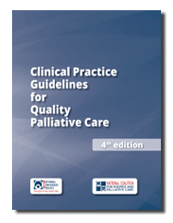Elevating Patient and Caregiver Voices
Two new patient reported experience measures are available for palliative care and other healthcare clinicians to implement in their practice.
Under the Medicare Access and CHIP Reauthorization Act of 2015 (MACRA), the Centers for Medicare and Medicaid Services (CMS) was directed to develop performance measures for clinicians. To meet these requirements, CMS contracted with the American Academy of Hospice and Palliative Medicine (AAHPM) to develop two patient reported outcome performance measures (PRO-PMs) in the areas of pain/symptom management and communication for patients with serious illness, including those receiving palliative care.
To fulfill their requirements, AAHPM partnered with the National Coalition of Hospice and Palliative Care (NCHPC) and RAND Health (RAND) to establish the Palliative Care Quality Measures Project and develop two patient-centered palliative care measures for CMS’s Quality Payment Program (QPP) including the Merit-Based Incentive Payment System (MIPS) and alternative payment models (APMs).
By the end of the project, two new patient reported experience measures were tested at over 43 outpatient palliative care programs across the U.S. and are now available for palliative care and other clinicians to evaluate the quality of care they deliver based upon patient reported experience.
Specifically, the measures assess the quality of care provided by asking:
1
How much patients felt heard and understood
Feeling Heard and Understood
Measure Description: This is a multi-data element measure consisting of four data elements: Q1: “I felt heard and understood by this provider and team,” Q2: “I felt this provider and team put my best interests first when making recommendations about my care,” Q3: “I felt this provider and team saw me as a person, not just someone with a medical problem,” Q4: “I felt this provider and team understood what is important to me in my life.”
Denominator: All patients aged 18 years and older who had an ambulatory palliative care visit.
Numerator: Calculated using top-box scoring which reflects the percentage of patient respondents that give the most positive response across the four data elements.
2
If patients got the help they wanted for their pain
Receiving Desired Help for Pain
Measure Description: The percentage of patients aged 18 years and older who had an ambulatory palliative care visit and report getting the help they wanted for their pain from their palliative care provider and team within 6 months of the ambulatory palliative care visit.
Denominator: All patients aged 18 years and older who had an ambulatory palliative care visit.
Numerator: The number of patients aged 18 years and older who report getting the help they wanted for their pain by their palliative care provider and team within 6 months of the ambulatory palliative care visit.
What are Patient Reported Experience Measures
The two measures fall under the category of “patient reported outcome performance measures” or “PRO-PMs” and are intended for palliative care clinicians to evaluate the quality of care they deliver based upon patient reported experience.


Why Use These Measures
These measures can help you gauge that your program is truly providing patient-centered care. The measures apply a person-centered approach that recognizes the person beyond the disease and prioritizes peoples’ health concerns as they see them. These measures can help you identify resources such as training or protocols you might need to provide high- value excellent patient care. The measures are in alignment with the top needs people want from their clinicians. These measures can ensure you are addressing the most significant gaps in care today – patient centered, effective symptom care and communication.
How to Use These Measures
Clinicians can use these measures NOW to:
- Assess how well patients’ needs are being met
- Implement as part of a larger quality improvement (QI) effort to understand patient experience
- Identify and advocate for resources critical to improving patient care and experience
- Reward and encourage those who are providing high-quality care
- Provide support for improving care processes
- Guide education to effectively manage all types of pain and conduct meaningful conversations with patients
- Provide education to patients about pain management to properly set expectations
- Conduct research with patients to examine external factors that affect their experience of care


Who Led the Project
The Palliative Care Measure Project was led by the American Academy of Hospice and Palliative Medicine (AAHPM), in collaboration with the RAND Corporation and National Coalition for Hospice and Palliative Care, and was funded under the Medicare Access and CHIP Reauthorization Act of 2015 (MACRA).
How the Measures were Developed
This project followed a rigorous development process guided by the Centers for Medicare & Medicaid Services Measures Management System (CMS MMS) and the National Quality Forum (NQF) requirements.


Who Funded the Project
This project was funded was through a cooperative agreement between the Centers for Medicare and Medicaid Services (CMS) and American Academy of Hospice and Palliative Medicine (AAHPM) from September 2018 to September 2021. The cooperative agreement number is 1V1CMS331639-03-00.
Review the Business Case for Each Measure

- These measures can help you gauge that your program is truly providing patient-centered care. The measures apply a person-centered approach that recognizes the person beyond the disease and prioritizes peoples’ health concerns as they see them.
- These measures can help you identify resources such as training or protocols you might need to provide high- value excellent patient care. The measures are in alignment with the top needs people want from their clinicians.
- These measures can ensure you are addressing the most significant gaps in care today – patient centered, effective symptom care and communication. (See Clinical Practice Guidelines for Quality Palliative Care, 4th edition)
Learn about the Measures
Person-Centered Approach
Measures Endorsed by NQF

The measures have been endorsed by the National Quality Forum (NQF) during the fall 2021 review cycle.
